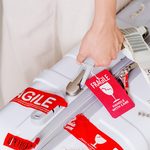Travelling with Diabetes
There's no reason diabetes should hold you back from traveling, as long as you take some reasonable precautions to make sure that while you're getting away, your blood sugar isn't.

Your mantra is “Plan ahead.” Let your doctor know your itinerary. Depending on how long you’ll be gone, he may want to give you a thorough examination before you depart. And to ensure smooth sailing, heed the following advice.
- Keep glucose goods close at hand. If you are travelling by plane, pack your medications, insulin, syringes, test strips, lancets, ketone strips, and other supplies in your carry-on bag so there’s no chance of losing them. Consider bringing extra supplies in your checked luggage. Make sure all medications bear the original pharmacy prescription labels.
- Pack a snack. Wherever you go, take a totable snack like an apple, an energy bar, a banana, raisins, or cheese and crackers in case your blood sugar starts to dip when you don’t have immediate access to other food. If you sample your snacks en route, replenish your supplies as soon as you can.
- Anticipate airport security. With the increased security at airports, expect your supplies to get a thorough once-over. But the Federal Aviation Administration (as of press time) allows you to board a plane with insulin, syringes, and insulin-delivery systems as long as you can document that you need them. The letter from your doctor will help, but it won’t be sufficient on its own. Make sure you carry your insulin vials in their boxes, which bear preprinted pharmaceutical labels, and once you use the insulin, keep the box. (Don’t open your glucagon kit unless you need it.) It’s okay to carry lancets on board as well, as long as they’re capped and you also carry a glucose meter with a manufacturer’s name printed on it. Be sure to call ahead for current policies before you leave. If you use an insulin pump, don’t disconnect it prior to entering airport security. However, if you’re wearing a continuous glucose sensor, you’ll need to disable it because the radio frequencies it emits can interfere with the plane’s in-flight navigation system.
- Mind your meals. If you’re flying or taking an extended trip by rail, call the carrier a few days before you depart and ask what special meals they have available for people with diabetes or heart disease (there may be more than one option to choose from). When you’re en route, wait for meal service to actually begin before you take your pre-meal insulin to make sure you don’t experience low blood sugar in the event that service is unexpectedly slowed or canceled. When travelling by car, try to stick to your regular mealtime schedule to keep your blood sugar stable. If that’s not possible, carry glucose tablets along with you and be alert to symptoms of low blood sugar, such as nervousness, sweating, and crankiness. If you feel a hypoglycemic episode coming on, pull over and take several glucose tablets. Wait at least 10 to 15 minutes for the feeling to pass before continuing on.
- Get in the zone. Travelling across different time zones can throw your normal insulin and meal schedule completely out of kilter, but you can compensate for the disruption if you’re careful. When adding hours to your day by travelling west, you may need to take more insulin. When losing hours by travelling east, you may need less. Check with your doctor for specific recommendations. As for timing your injections and meals, keep your watch set to your home time as you travel to your destination, then switch your watch-and your schedule-to the local time the morning after you arrive.
- Organize for overseas. If you’re travelling outside the country, be aware that insulin you find abroad may be sold in weaker strengths than the insulin available in the United States, which has standardized its insulin in a dose known as U-100. Each insulin strength (such as U-40 and U-80) requires specially matched syringes. Filling a different type of syringe with your U.S. insulin will make your dose inaccurate. Best bet: Stick to your own supplies. If you must buy insulin that’s a different strength, also buy syringes to match.
Originally Published: June 07, 2010



